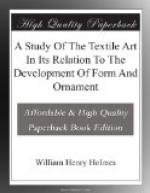Needlework arose in the earliest stages of art and at first was employed in joining parts, such as leaves, skins, and tissues, for various useful purposes, and afterwards in attaching ornaments. In time the attaching media, as exposed in stitches, loops, knots, and the like, being of bright colors, were themselves utilized as embellishment, and margins and apertures were beautified by various bindings and borders, and finally patterns were worked in contrasting colors upon the surfaces of the cloths and other materials of like nature or use.
No other art so constantly and decidedly suggested embellishment and called for the exercise of taste. It was the natural habitat for decoration. It was the field in which technique and taste were most frequently called upon to work hand in hand.
With the growth of culture the art was expanded and perfected, its wonderful capacity for expression leading from mere bindings to pretentious borders, to patterns, to the introduction of ideographs, to the representation of symbols and mythologic subjects, and from these to the delineation of nature, the presentation of historical and purely pictorial scenes.
And now a few words in regard to the character of the work and its bearing upon the geometric system of decoration. As purely constructive ornamentation has already been presented, I will first take up that class of superconstructive work most nearly related to it. In some varieties of basketry certain bindings of the warp and woof are actually left imperfect, with the idea of completing the construction by subsequent processes, the intersections being gone over stitch by stitch and lashed together, the embroidery threads passing in regular order through the openings of the mesh. This process is extremely convenient to the decorator, as changes from one color to another are made without interfering with construction, and the result is of a closely similar character to that reached by working the colors in with warp and woof. In a very close fabric this method cannot be employed, but like results are reached by passing the added filaments beneath the protruding parts of the bindings and, stitch by stitch, covering up the plain fabric, working bright patterns. Fig. 336 is intended to show how this is done. The foundation is of twined work and the decorating fillets are passed under by lifting, with or without a needle. This process is extensively practiced by our west coast tribes, and the results are extremely pleasing. The materials most used are quills and bright colored straws, the foundation fabric being of bark or of rushes. The results in such work are generally geometric, in a way corresponding more or less closely with the ground work combination.
[Illustration: FIG. 336. Grass embroidery upon the surface of closely impacted, twined basketry. Work of the northwest coast Indians.]




